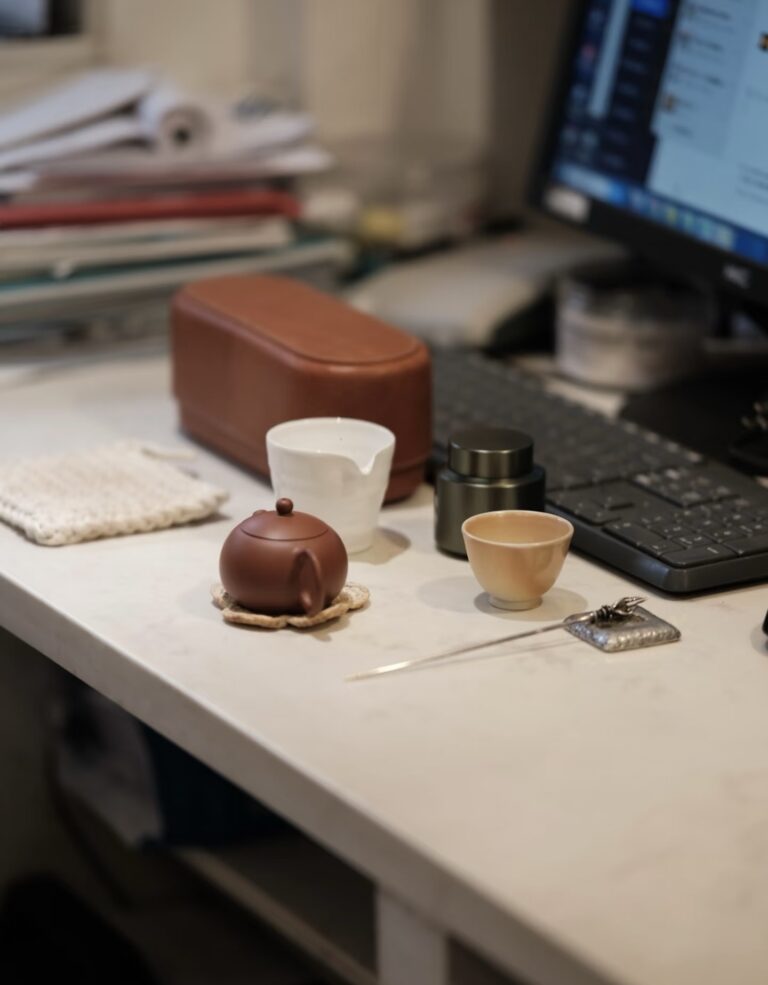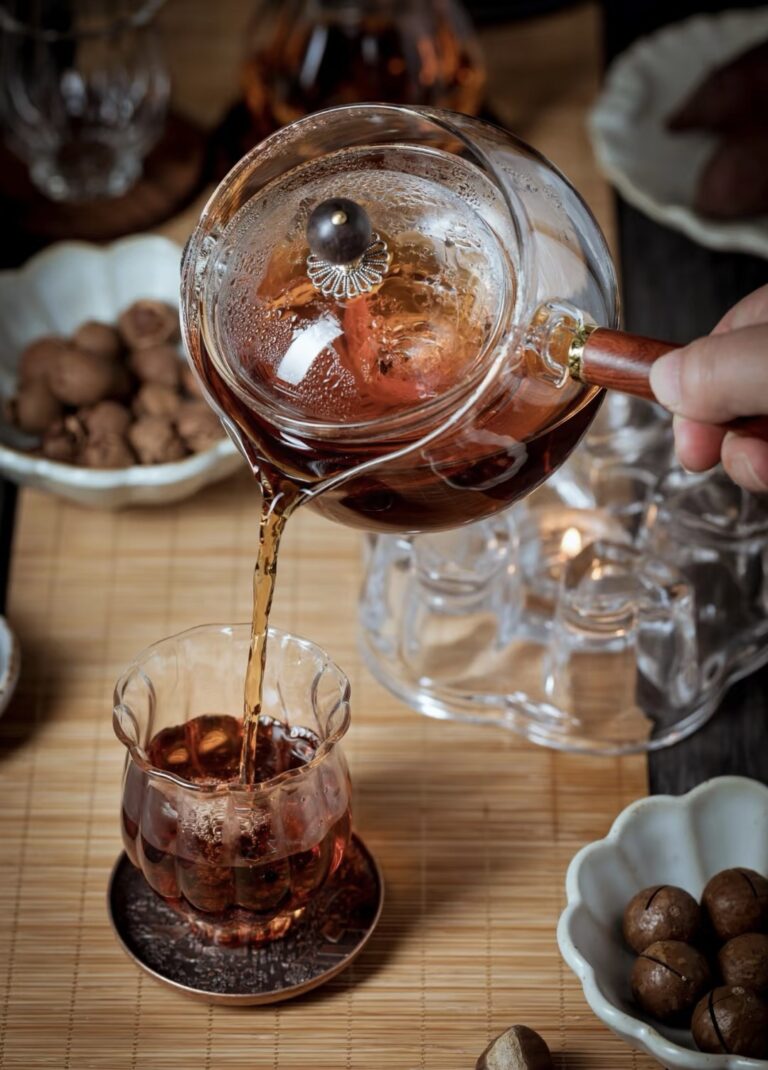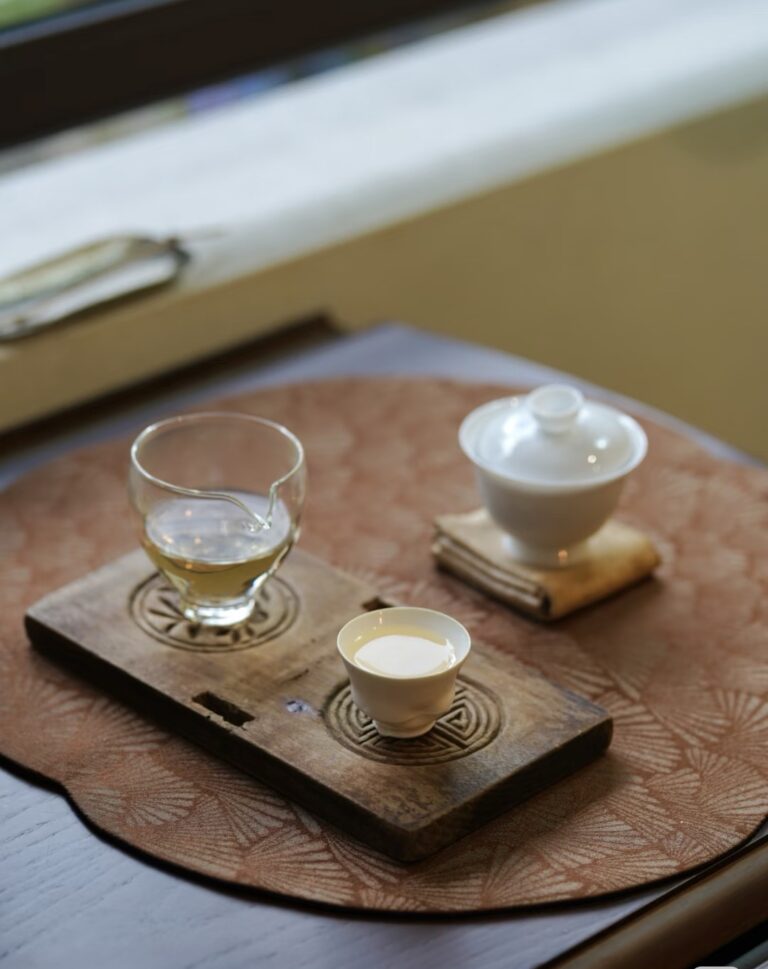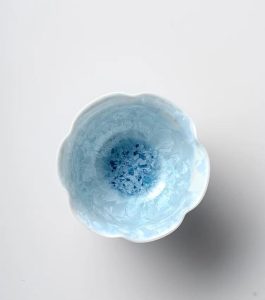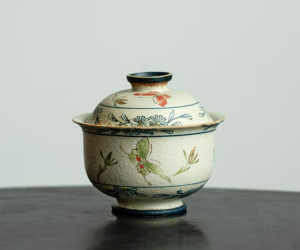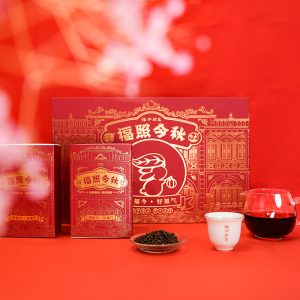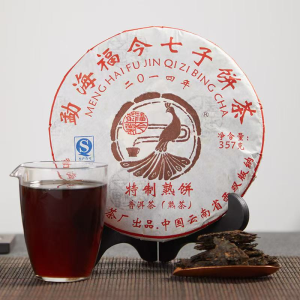
Pu-erh tea, celebrated for its “aged to perfection” quality and the adage “one mountain, one flavor,” holds a revered spot in the tea world. For connoisseurs and novices alike, the classic formula for appreciating Pu-erh’s intricate flavors involves a gaiwan, boiling water, a quick rinse to awaken the leaves, and swift infusions. This comprehensive guide, informed by rigorous testing, will unlock the golden brewing parameters for various Pu-erh types. For those new to this fascinating brew, understanding “What is Pu-erh Tea” is the first step.
The Gaiwan Advantage for Pu-erh Tea
A gaiwan, typically made of porcelain with a wide top and narrow base, is the ideal vessel for brewing Pu-erh tea. Its design allows for an objective assessment of the tea’s true quality, uninfluenced by the material of the brewing vessel. Pu-erh, originating from Yunnan large-leaf varietal tea leaves, particularly benefits from 100°C (212°F) boiling water and a pre-infusion rinse (also known as “waking up the tea”) to fully release its rich internal substances and aromatic compounds.
Official standards, such as the “Pu-erh Tea Brewing Methods” (Yunnan Provincial Standard DB53/T 236-20), explicitly recommend using boiling water and performing one to two rinses before formal brewing. This crucial step prepares the leaves, ensuring an optimal extraction of flavor.


Enhance your Pu-erh brewing ritual; explore FONG’S TEA exquisite collection of gaiwans designed for perfect tea enjoyment.
Understanding Pu-erh Tea Varieties and Their Flavor Profiles
The diverse processing and forms of Pu-erh tea yield distinctive flavor experiences. The “Geographical Indication Product Pu-erh Tea” (GB/T 22111-2008) outlines key tasting notes for both loose-leaf Raw Pu-erh (Sheng Pu) and Ripe Pu-erh (Shu Pu):
- High-Grade Loose-Leaf Raw Pu-erh (Sheng Pu): Characterized by a strong, clear aroma and a rich, mellow taste with a sweet aftertaste.
- Loose-Leaf Ripe Pu-erh (Shu Pu): Exhibits a rich aged aroma and a predominantly mellow and thick taste.


The standard further describes pressed Pu-erh:
- Pressed Raw Pu-erh: Demands a pure aroma and a thick, rich taste.
- Pressed Ripe Pu-erh: Features a unique aged aroma and a mellow, sweet aftertaste.

The diverse processing and forms of Pu-erh tea yield distinctive flavor experiences, reflecting the intricate craftsmanship involved in how Pu-erh tea is made. Beyond these classifications, variations in origin (Xishuangbanna, Lincang, Pu-erh City) and vintage significantly influence aroma and taste, underscoring the importance of exploring different Pu-erh regions. When these variables intertwine, the tea-to-water ratio and steeping time become critical factors in shaping the final flavor.
In-Depth Pu-erh Brewing Experiment

To decode the flavor secrets within each cup, our team embarked on a rigorous testing journey. We meticulously selected Pu-erh teas crafted from raw materials across three major producing areas—Xishuangbanna (represented by Yiwu), Lincang (represented by Bingdao), and Pu-erh City (represented by Jingmai). These representative mountain areas offer valuable insights applicable to their broader regions.
Our experiment covered both Sheng Pu and Shu Pu systems, focusing on three golden ages: one, three, and seven years. We tested both loose-leaf and pressed tea cakes, systematically varying the tea-to-water ratio and steeping times.
The provincial Pu-erh tea brewing standard (2007) suggested a tea-to-water ratio of 1:40 to 1:60 and steeping times under one minute for the first three infusions. However, acknowledging its age, we also consulted the “Pu-erh Tea Brewing Methods” (Pu-erh City Group Standard T/PCX 02-2020), which recommends a 10-second rinse with boiling water, a tea-to-water ratio of 1:14-1:16, and specific steeping times for the first five infusions.




For a standardized 110ml tasting gaiwan, a 1:40-1:60 ratio equates to 1.83g-2.75g of tea, while 1:14-1:16 requires 6.8g-7.85g. Considering popular brewing habits, we set our tea-to-water ratios at 1:14, 1:18, and 1:22.
To account for the different tea-to-water ratios, we defined three sets of steeping times for the first three infusions:
- Set 1: 15 seconds, 15 seconds, 20 seconds
- Set 2: 20 seconds, 20 seconds, 25 seconds
- Set 3: 25 seconds, 25 seconds, 30 seconds
You might notice that the first two infusions often share the same steeping time. This is because Yunnan large-leaf varietals are rich in natural compounds, and after processing, Pu-erh tea contains abundant soluble substances. Thus, the second infusion often doesn’t require an extended steeping time.
Our objective was clear: under consistent conditions of a standardized gaiwan and 100°C (212°F) pure water, identify the “golden brewing parameters” resulting from specific combinations of tea-to-water ratio and steeping time that yield the best Pu-erh tea flavor.
After dozens of rounds and thousands of cups of rigorous testing and comparison, controlling for key variables, our Pu-erh tea brewing assessment results are finally here. Today, we share the most recommended tea-to-water ratios and steeping times for brewing Sheng Pu and Shu Pu from different regions, ages, and forms. Please note that these conclusions are subjective recommendations based on our samples and individual sensory evaluations, serving as a valuable reference for your daily Pu-erh tea brewing.
Golden Brewing Parameters by Pu-erh Origin and Type
Xishuangbanna Pu-erh (Yiwu Focus)
Yiwu is a benchmark mountain in Xishuangbanna, home to renowned micro-regions like Bingtang, Duoyishu, and Tianmenshan. Yiwu tea is celebrated for its “high aroma and soft water, with a sweet, smooth entry,” captivating countless tea lovers. However, its prized high aroma demands thorough rinsing during brewing.
Proper rinsing allows Yiwu tea to fully release its fragrance and mellow its taste. Hasty or insufficient rinsing prevents the leaves from fully unfurling and heating evenly, “sealing” its captivating aroma. Generally, for relatively loose-leaf Yiwu Sheng Pu, rinse for under 8 seconds. For pressed Yiwu tea cakes, rinse for under 15 seconds, with tighter cakes requiring longer rinses.
After thorough rinsing, we tested one-year, three-year, and seven-year Yiwu Sheng Pu (loose leaf and pressed) and Shu Pu (loose leaf and pressed) with 1:14, 1:18, and 1:22 tea-to-water ratios. The recommended ratios varied:
Yiwu Sheng Pu:
- 1-year and 3-year (loose leaf or pressed): Recommended ratio is 1:18.
- 7-year (loose leaf or pressed): Recommended ratio is 1:22.
- All ages and forms: The first three infusions are best steeped for 25 seconds, 25 seconds, and 30 seconds. This sufficient infusion time ensures a high aroma and highlights a rich, sweet, and mellow taste.
| Category | Age | Tea-to-Water Ratio | 1st Infusion | 2nd Infusion | 3rd Infusion | Tasting Notes |
| Loose Leaf Sheng Cha (Raw) | 1 Year | 1:18 | 25″ | 25″ | 30″ | Sweet with a mellow, thick aftertaste; balanced across three infusions. |
| 3 Years | 1:18 | 25″ | 25″ | 30″ | Mellow with noticeable astringency; a distinct sense of “rhyme” or depth. | |
| 7 Years | 1:22 | 25″ | 25″ | 30″ | Good drinkability, sweeter and smooth. The third infusion shows good leaf quality and a mellow taste. | |
| Compressed Sheng Cha (Raw) | 1 Year | 1:18 | 25″ | 25″ | 30″ | High aroma, thick mouthfeel, and strong drinkability. |
| 3 Years | 1:18 | 25″ | 25″ | 30″ | High aroma and mellow taste with no noticeable astringency. | |
| 7 Years | 1:22 | 25″ | 25″ | 30″ | Good drinkability, sweeter and smooth. The third infusion shows good leaf quality and a mellow taste. |
Yiwu Shu Pu:
- Yiwu Shu Pu offers more brewing flexibility, making it beginner-friendly.
- Loose-leaf (all three ages): Recommended ratio is 1:22.
- Pressed (all three ages): Recommended ratio is 1:18.
- All ages and forms (loose and pressed): The first three infusions are also best steeped for 25 seconds, 25 seconds, and 30 seconds, yielding a high aroma, rich mellow taste, and excellent drinkability.
| Category | Age | Tea-to-Water Ratio | 1st Infusion | 2nd Infusion | 3rd Infusion | Tasting Notes |
| Loose Leaf Shou Cha (Ripe) | 1 Year | 1:22 | 25″ | 25″ | 30″ | Balanced drinkability, mellow, and smooth overall. |
| 3 Years | 1:22 | 25″ | 25″ | 30″ | Lingering aroma, good drinkability, and relatively mellow taste. | |
| 7 Years | 1:22 | 25″ | 25″ | 30″ | Higher aroma, thick and mellow aftertaste. | |
| Compressed Shou Cha (Ripe) | 1 Year | 1:18 | 25″ | 25″ | 30″ | The mouthfeel is moderately thick with a good aroma. |
| 3 Years | 1:18 | 25″ | 25″ | 30″ | Mellow and smooth with a sustained aroma. | |
| 7 Years | 1:18 | 25″ | 25″ | 30″ | Rich aroma, good body, and high fullness. |
Lincang Pu-erh (Bingdao Focus)
Known as the “Tea Granary of the World,” Lincang is now most famous for Bingdao Pu-erh, cherished for its rich fruity-honey aroma, unique rock candy sweetness, melting mouthfeel, and low bitterness. To fully showcase Bingdao tea’s core charms, rinsing remains an essential step before adjusting the tea-to-water ratio and steeping time for different ages and forms of Bingdao Sheng Pu and Shu Pu.
Bingdao Sheng Pu:
- 1-year loose leaf: Recommended ratio is 1:14.
- 3-year and 7-year loose leaf: Recommended ratio is 1:18.
- All ages loose leaf: First three infusions for 25 seconds, 25 seconds, 30 seconds. The tea soup presents: 1-year with balanced aroma and water, clear sweetness; 3-year mellow and smooth; 7-year with a long, subtle aroma, mellow taste, and prominent sweetness.
- All ages pressed: Recommended ratio is 1:18.
- 1-year and 3-year pressed: First three infusions for 25 seconds, 25 seconds, 30 seconds. Longer steeping times better release the aroma of younger (1 and 3-year) pressed Bingdao Sheng Pu, resulting in a more mellow and sweet tea soup.
- 7-year pressed: First three infusions for 15 seconds, 15 seconds, 20 seconds. With appropriate water temperature (100°C) and thorough rinsing, the first two infusions of 7-year Bingdao Sheng Pu cake only need 15 seconds, offering a moderate aroma, mellow taste, and improved drinkability.
| Vintage | Form | Tea-to-Water Ratio | 1st Infusion | 2nd Infusion | 3rd Infusion | Conclusion |
| One-year | Loose Leaf | 1:14 | 25″ | 25″ | 30″ | Balanced aroma and water, clear sweetness with a pleasant aftertaste. |
| Three-year | Loose Leaf | 1:18 | 25″ | 25″ | 30″ | Mellow and smooth tea soup, strong drinkability, mellow sweetness. |
| Seven-year | Loose Leaf | 1:18 | 25″ | 25″ | 30″ | Mellow taste, long subtle aroma, prominent sweetness. |
| One-year | Pressed Tea | 1:18 | 25″ | 25″ | 30″ | Full aroma release, sweet with a rich thickness, not thin. |
| Three-year | Pressed Tea | 1:18 | 25″ | 25″ | 30″ | Mellow and moist, good aftertaste, rich aroma. |
| Seven-year | Pressed Tea | 1:18 | 15″ | 15″ | 20″ | Moderate aroma, mellow taste, strong drinkability. |
Bingdao Shu Pu:
- 1-year loose leaf: Recommended ratio is 1:14.
- All other types (1-year pressed, 3-year loose/pressed, 7-year pressed): Recommended ratio is 1:18.
- 1-year and 3-year (loose and pressed): First three infusions for 25 seconds, 25 seconds, 30 seconds. Overall, high aroma, mellow and smooth body, good sweetness, and rhyme.
- 7-year pressed: First three infusions for 25 seconds, 25 seconds, 25 seconds. Compared to same-age Bingdao Sheng Pu loose leaf, the first two infusions are 10 seconds longer, resulting in a moderate aroma, mellow taste, and strong drinkability.
| Vintage | Form | Tea-to-Water Ratio | 1st Infusion | 2nd Infusion | 3rd Infusion | Conclusion |
| One-year | Loose Leaf | 1:14 | 25″ | 25″ | 30″ | High aroma, sustained, mellow body. |
| Three-year | Loose Leaf | 1:18 | 25″ | 25″ | 30″ | High aroma, mellow and smooth body. |
| Seven-year | Loose Leaf | — | — | — | — | No 7-year aged Bingdao Shu Pu-erh loose leaf found. |
| One-year | Pressed Tea | 1:18 | 25″ | 25″ | 30″ | Mellow and smooth body, sustained aroma. |
| Three-year | Pressed Tea | 1:18 | 25″ | 25″ | 30″ | High aroma, distinct characteristics, good sweetness and aftertaste. |
| Seven-year | Pressed Tea | 1:18 | 25″ | 25″ | 25″ | Moderate aroma, mellow taste, strong drinkability |
Pu-erh City Pu-erh (Jingmai Focus)
Jingmai Mountain, one of the most famous Pu-erh tea mountains, boasts an ancient tea forest cultural landscape honored as the “world’s first tea culture themed World Heritage site.” Jingmai tea, thriving in harmony with its pristine forest, develops an enchanting “orchid fragrance and wild charm”—a clear, deep orchid aroma and a unique wild essence that imparts vitality and liveliness to the tea soup.
A well-executed rinse is also the crucial step to awaken the soul of Jingmai tea. It not only lays the foundation for subsequent aroma and flavor but also helps remove faint storage odors and environmental雜味 (miscellaneous odors) adsorbed by older teas.
After a thorough rinse, our testing of Jingmai Sheng Pu revealed:
Jingmai Sheng Pu:
- 1-year loose leaf: Recommended ratio is 1:18, with first three infusions for 15 seconds, 15 seconds, 20 seconds. This yields a high aroma and excellent tea soup sweetness.
- 3-year and 7-year loose leaf: Recommended ratio is 1:22, with first three infusions for 25 seconds, 25 seconds, 30 seconds. This produces a long-lasting aroma and a mellow, sweet tea soup with a pleasant aftertaste.
- 1-year and 3-year pressed: Recommended ratio is 1:18, with first three infusions for 25 seconds, 25 seconds, 30 seconds. Overall, mellow, sweet, rich aroma, and smooth body.
- 7-year pressed: Recommended ratio is 1:22, with first three infusions for 25 seconds, 25 seconds, 30 seconds. Overall, mellow, sweet, rich aroma, and smooth body.
| Vintage | Form | Tea-to-Water Ratio | 1st Infusion | 2nd Infusion | 3rd Infusion | Conclusion |
| One-year | Loose Leaf | 1:18 | 15″ | 15″ | 20″ | High aroma, good sweetness, better durability. |
| Three-year | Loose Leaf | 1:22 | 25″ | 25″ | 30″ | Long subtle aroma, strong drinkability, mellow taste. |
| Seven-year | Loose Leaf | 1:22 | 25″ | 25″ | 30″ | Strongest overall drinkability, fully stimulates aroma, mellow and sweet aftertaste. |
| One-year | Pressed Tea | 1:18 | 25″ | 25″ | 30″ | Thick mellow aftertaste, rich aroma, good durability. |
| Three-year | Pressed Tea | 1:18 | 25″ | 25″ | 30″ | Mellow and sweet, good rhyming sensation, rich aroma. |
| Seven-year | Pressed Tea | 1:22 | 25″ | 25″ | 30″ | Mellow and sweet, no bitterness/astringency, smooth body. |
Jingmai Shu Pu:
- All three ages (loose leaf): Recommended ratio is 1:18, with first three infusions for 25 seconds, 25 seconds, 30 seconds. The tea soup generally offers a moderate aroma, mellow sweetness, and a clear body.
- All three ages (pressed cake): Recommended ratio is 1:22, with first three infusions for 25 seconds, 25 seconds, 30 seconds. The tea soup is thick, smooth, with a clear aroma, and excellent drinkability.
| Vintage | Form | Tea-to-Water Ratio | 1st Infusion | 2nd Infusion | 3rd Infusion | Conclusion |
| One-year | Loose Leaf | 1:18 | 25″ | 25″ | 30″ | Clear quality characteristics, mellow taste, moderate aroma. |
| Three-year | Loose Leaf | 1:18 | 25″ | 25″ | 30″ | Thick mellow aftertaste, high aroma that dissolves into the soup. |
| Seven-year | Loose Leaf | 1:18 | 25″ | 25″ | 30″ | Moderate aroma, mellow and sweet aftertaste. |
| One-year | Pressed Tea | 1:22 | 25″ | 25″ | 30″ | Clear regional characteristics, thick and smooth body, clear aroma. |
| Three-year | Pressed Tea | 1:22 | 25″ | 25″ | 30″ | Better smoothness in body, clear characteristics. |
| Seven-year | Pressed Tea | 1:22 | 25″ | 25″ | 30″ | Good aroma, mellow and clear, strong drinkability, no apparent flaws. |
General Brewing Principles for Sheng vs. Shu Pu-erh
Overall, mastering Pu-erh tea brewing hinges on precise time control! For naturally fermented Sheng Pu, both rinsing and steeping times should generally be shorter rather than longer. This prevents the tea from becoming too strong or astringent, preserving its nuanced flavors.
Conversely, cold-piled fermented Shu Pu is appreciated for its warmth and mellow richness. Therefore, both rinsing and steeping times should be longer rather than shorter. If infused too briefly, Shu Pu’s depth and unique charm will not fully emerge, resulting in a bland and uninspired cup.
Conclusion
Brewing a perfect cup of Pu-erh tea is a rewarding journey. While our rigorous testing provides a scientific foundation for optimal brewing, remember that personal preference plays a significant role. Use this guide as a starting point, and feel free to adjust parameters to discover your own perfect Pu-erh experience. Beyond its complex flavors, many tea drinkers also explore the renowned health benefits of Pu-erh tea, adding another dimension to this ancient beverage. Ready to explore the diverse world of Pu-erh? Browse FONG’S TEA curated selection of premium Pu-erh teas and start your personalized tasting journey today!
Note: The brewing conclusions presented are based on specific samples, sampling methods, and individual sensory evaluations by FONG’S TEA team. They serve as subjective recommendations and should be used as a reference for your daily Pu-erh tea brewing.
FAQs about Gaiwan Brewing Pu-erh Tea
A gaiwan is a traditional Chinese lidded bowl used for brewing tea. It’s highly recommended for Pu-erh tea because its porcelain material allows for an objective evaluation of the tea’s true flavor profile without imparting any external tastes. Its wide opening also helps the leaves expand fully and cool slightly for optimal aromatic release.
Rinsing Pu-erh tea, especially with boiling water, serves several crucial purposes: it awakens the compressed or dormant tea leaves, allowing them to unfurl and release their full aroma and flavor more effectively. For older Pu-erh, it also helps wash away any dust or faint storage odors, ensuring a cleaner, purer tasting experience.
Generally, Raw (Sheng) Pu-erh, being less fermented, benefits from shorter rinsing and steeping times to prevent over-extraction, which can lead to excessive bitterness or astringency. Ripe (Shu) Pu-erh, being fermented, thrives with slightly longer rinsing and steeping times to fully draw out its warm, mellow, and rich characteristics. Adjustments also vary by age, form (loose vs. pressed), and region.
Yes, absolutely. Older Pu-erh teas, particularly aged raw Pu-erh, often require slightly different parameters. While younger Pu-erh might need slightly longer initial steeping to break through its youthful intensity, older Pu-erh might require quicker infusions, especially for the first few, as its soluble compounds are more readily available. Pressed teas, regardless of age, generally need a longer rinse and sometimes slightly longer initial steeps to encourage the compacted leaves to open up.
While some teas benefit from cooler water, Pu-erh tea, particularly the Yunnan large-leaf varietal, is generally best brewed with 100°C (212°F) boiling water. This high temperature is essential to fully extract the rich internal substances, complex aromas, and deep flavors that Pu-erh tea is known for, especially for pressed and aged varieties. Using cooler water may result in a weaker, less complex infusion.

